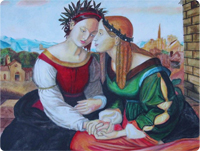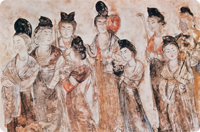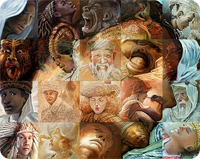


A mural is a painting on a wall, ceiling, or other large permanent surface.
Murals of sorts date to prehistoric times such as the paintings on the Caves of Lascaux in southern France. There are many techniques. The most well known is probably "fresco", which uses water soluble paints with a damp lime wash, a rapid use of the resulting mixture over a large surface, and often in parts (but with a sense of the whole). The colors lighten when dried
The most famous contemporary mural is probably Guernica, by Pablo Picasso. Picasso's painting commemorates a small Basque village bombed by The German Luftwaffe in April 1937 during the Spanish Civil War in support of Francisco Franco's Nationalist army. Picasso depicts a nightmarish scene of men, women, children and animals under bombardment. Art historian Herbert Read described the work as "a cry of outrage and horror amplified by a great genius". The second most famous mural is probably the eight-panel Water Lilies (1926), by the Impressionist Claude Monet.
Among the world's most famous muralists are Diego Rivera, David Alfaro Siqueiros, José Clemente Orozco, Bogside Artists and Gert Neuhaus.
Murals are a relatively effective tool of social emancipation or achieving a political goal. Murals have sometimes been created against the law or have been commissioned by local bars and coffeeshops. Often, the visual effects are an enticement to attract public attention to social issues like the legalization of soft drugs, racial integration and social security, or an attempt to break social and historic taboos and provoke the open discussion about issues like the haringoproer (an anti-monarchist uprising in 19th century Amsterdam) or the theory of New World Order. This is achieved by installing what are seen as provocative murals at strategic locations in Amsterdam's city centre. World famous are the murals in Belfast and Los Angeles which have functioned as an important means of communication for members of socially, ethnically and racially divided communities in times of conflict. They also proved to be an effective tool in establishing a dialogue and hence solving the cleavage in the long run. State-sponsored public art expressions, particularly murals, are often used by totalitarian regimes as a tool of mass-control and propaganda. However dispute the propagandist character of that works, some of them still have an artistic value.
Northern Ireland contains arguably the most famous political murals. Almost 2,000 murals have been documented in Northern Ireland since the 1970s. Although the murals more often than not represent violence or intolerance, they are renowned for their professional nature and the incredible level of skill of the artists creating them.
Almost all of the Northern Ireland murals promote either republican or unionist political beliefs, often glorifying paramilitary groups such as the Provisional Irish Republican Army and the Ulster Volunteer Force, while others commemorate people who have lost their lives in terrorist attacks. Many loyalist artists incorporate messages of religious intolerance into politically-driven murals.
The most famous of the murals in Northern Ireland may well be Free Derry Corner, where the slogan "You Are Now Entering Free Derry" was painted in 1969, shortly after the Battle of the Bogside. However, some do not consider Free Derry Corner to be a true mural as it is only words and not images. Free Derry Corner has been used as a model for other murals in Northern Ireland, including the "You Are Now Entering Loyalist Sandy Row" mural in Belfast, which was a response to the republican message of Free Derry Corner, and the "You Are Now Entering Derry Journal Country" mural, which is an advertisement for a Derry publication.



